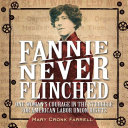2018 School Spending Survey Report
Fannie Never Flinched: One Woman's Courage in the Struggle for American Labor Union Rights
56p. bibliog. chron. further reading. glossary. index. notes. photos. websites. Abrams. Nov. 2016. Tr $19.95. ISBN 9781419718847.
COPY ISBN
 Gr 4–6—The narrative begins with the murder of Fannie Sellins by deputies in Natrona, PA, in 1919 and then goes back 20 years to when Sellins first started working at the Marx and Haas garment factory and helped form the local United Garment Workers of America (UGWA) in St. Louis. Sellins moved up the UGWA ladder and traveled the country talking about the plight of factory workers: long days, low pay, and unsafe working conditions. Word of Sellins's abilities reached coal country, where she visited. Sellins supported the coal miners' efforts to unionize. When mine owners brought up scabs from the South, she chased their car along the railroad tracks, yelling at them not to break the coal miners' strike. Though there was no justice for her death, her memory lives on in coal country. In her author's note, Farrell details why she wrote about Sellins and discusses the difficulties she faced in finding reliable information about her subject's personal life. The text is matter-of-fact in tone, with captioned black-and-white photos and newsprint ads. The beige background features buttons, cogs, and stitches along the bottom of each page, and the end pages are scraps of seamed blue fabric.
Gr 4–6—The narrative begins with the murder of Fannie Sellins by deputies in Natrona, PA, in 1919 and then goes back 20 years to when Sellins first started working at the Marx and Haas garment factory and helped form the local United Garment Workers of America (UGWA) in St. Louis. Sellins moved up the UGWA ladder and traveled the country talking about the plight of factory workers: long days, low pay, and unsafe working conditions. Word of Sellins's abilities reached coal country, where she visited. Sellins supported the coal miners' efforts to unionize. When mine owners brought up scabs from the South, she chased their car along the railroad tracks, yelling at them not to break the coal miners' strike. Though there was no justice for her death, her memory lives on in coal country. In her author's note, Farrell details why she wrote about Sellins and discusses the difficulties she faced in finding reliable information about her subject's personal life. The text is matter-of-fact in tone, with captioned black-and-white photos and newsprint ads. The beige background features buttons, cogs, and stitches along the bottom of each page, and the end pages are scraps of seamed blue fabric.
VERDICT An essential purchase for public or large school libraries interested in workers' rights and social justice.
ALREADY A SUBSCRIBER? LOG IN
We are currently offering this content for free. Sign up now to activate your personal profile, where you can save articles for future viewing





Be the first reader to comment.
Comment Policy:
Comment should not be empty !!!